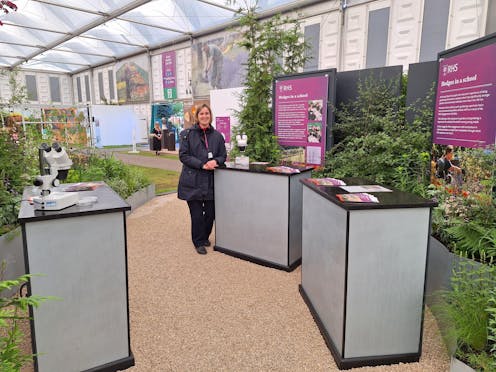
Most people associate the Royal Horticultural Society’s Chelsea Flower Show with innovative and inspiring garden design displays featuring plants galore. But the annual London show, which starts on Tuesday, May 21, also offers researchers like me a chance to showcase horticultural science to the general public.
This week, I’m taking urban hedges to Chelsea to highlight the year-round benefits of using mixed hedging, and to show the potential for humble hedges to be used more within environmental education.
Hedges are an important and widespread feature of urban and suburban areas. More than 40% of the UK’s 23 million gardens still have a hedge. They don’t take up much space, so they are popular as roadside dividers and boundary markers of parks and playgrounds. Hedges are also relatively cheap and simple to install and manage. And while fences provide privacy and mark boundaries, they lack the wealth of environmental benefits offered by hedges.
Hedges act as barriers for pollution, provide habitat for wildlife, support pollinators when in flower, produce berries for birds to feed on, capture rainfall and reduce flood risks, and (to a lesser degree) reduce noise. As a Royal Horticultural Society (RHS) scientist, I have noticed more gardeners, managers of public spaces, landscapers and architects, local councils, parents and schools wanting to learn about what hedges can do, and how they can be used to get more out of the green spaces.
As a part of my recent 1851 Royal Commission-funded project, I tested whether mixing evergreen and deciduous hedge species would be an advantage over using single species. Deciduous plants that shed their leaves in autumn and winter tend to provide more benefits during the summer months when in leaf. Evergreens – plants that keep their leaves all year round – provide benefits during the winter when other plants lose their leaves.

Over four seasons, I tested how well different types of hedge capture rainfall, reduce runoff, and minimise flood risks. I found that introducing evergreen plants such as Thuja, an evergreen conifer, into a deciduous hedge, such as hawthorn, reduced rainfall runoff in autumn and winter. In summer months, deciduous hawthorn hedges were best at absorbing excess water from the soil, so the ground could store more rainwater before becoming saturated.
The jury is still out on the detail, but the overall benefits of having a hedge vs no hedge are unequivocal.
An educational tool
My team and I worked with year-10 pupils at Hoe Valley School in Woking, Surrey, to assess the effects of planting two mixed hedges near a busy road on the school grounds. Pupils measured changes in moisture in the soil, deposits of air pollution particles on leaves, and temperatures around the hedges.
Curious to learn how hedges could be used to connect children with nature-based solutions like hedges, we tested how this horticultural research project changed pupils’ perspectives on what plants can do for the environment, and on their own willingness to get involved with growing – and caring for – greener spaces in their local area.

We found the pupils who had prior experience of doing gardening outside school had significantly stronger positive environmental attitudes than those who did not. But the pupils without prior gardening experience had a more pronounced positive attitude shift as a result of our science engagement activities.
So, exposure to environmental science and gardening both played a role in forming attitudes among young people. Getting involved with horticulture and environmental science while at school could be an important way to improve children’s connection with nature.
For Chelsea and beyond, I have teamed up with my RHS colleagues in the campaign for school gardening and national education nature park programme to pass on our ideas, resources, results and experiences to thousands of schools nationwide. By spreading the word further, we hope to encourage even more schools to get involved, use hedges as a teaching tool, and improve the environmental quality of their school grounds.
They might not be showy, expensive or elaborate, but hedges deserve much more attention. Hopefully, our display at Chelsea will get the public talking about the humble hedge, and encourage more home gardeners to use them as garden boundaries with a myriad of environmental benefits.

Don’t have time to read about climate change as much as you’d like?
Get a weekly roundup in your inbox instead. Every Wednesday, The Conversation’s environment editor writes Imagine, a short email that goes a little deeper into just one climate issue. Join the 30,000+ readers who’ve subscribed so far.
Tijana Blanusa works for the Royal Horticultural Society, and is based at the University of Reading. This project was funded by the Royal Commission for the Exhibition of 1851 (Built Environment Fellowship grant to TB)
This article was originally published on The Conversation. Read the original article.







